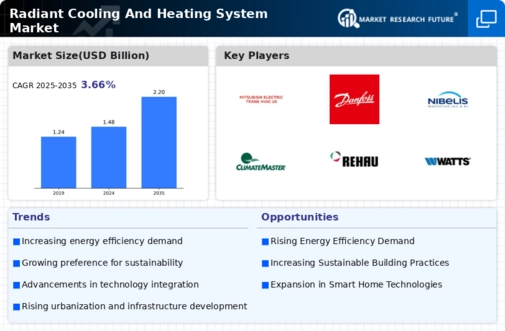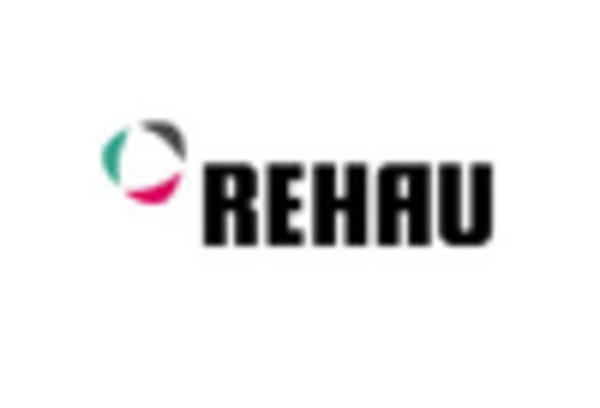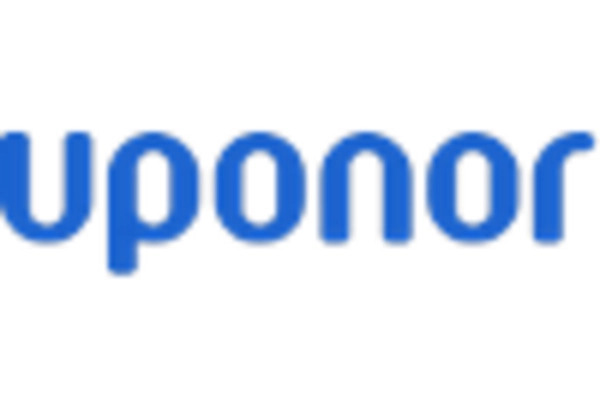Consumer Awareness and Education
Consumer awareness regarding the benefits of radiant systems is steadily increasing, which is positively impacting the Radiant Cooling And Heating System Market. As more individuals become informed about the advantages of radiant heating and cooling, such as improved comfort and energy savings, the likelihood of adoption rises. Educational initiatives and marketing campaigns are playing a crucial role in disseminating information about these systems. Additionally, as consumers seek alternatives to conventional HVAC systems, the appeal of radiant technologies is growing. This shift in consumer perception is expected to drive demand, further solidifying the position of the Radiant Cooling And Heating System Market in the broader HVAC landscape.
Rising Demand for Energy Efficiency
The Radiant Cooling And Heating System Market is experiencing a notable surge in demand for energy-efficient solutions. As energy costs continue to rise, consumers and businesses alike are increasingly seeking systems that minimize energy consumption while maximizing comfort. Radiant systems, which operate by distributing heat or cooling through floors or walls, are recognized for their ability to maintain consistent temperatures with lower energy usage. According to recent data, these systems can reduce energy consumption by up to 30% compared to traditional HVAC systems. This growing awareness of energy efficiency is likely to drive further adoption of radiant technologies, positioning the Radiant Cooling And Heating System Market for substantial growth in the coming years.
Technological Advancements in HVAC Systems
Technological innovations are playing a pivotal role in shaping the Radiant Cooling And Heating System Market. The integration of smart technologies, such as IoT-enabled thermostats and automated controls, enhances the functionality and efficiency of radiant systems. These advancements allow for precise temperature control and energy management, which can lead to significant cost savings for users. Furthermore, the development of advanced materials and installation techniques is improving the performance and reliability of radiant systems. As these technologies continue to evolve, they are expected to attract more consumers, thereby propelling the growth of the Radiant Cooling And Heating System Market.
Increased Focus on Sustainable Building Practices
The Radiant Cooling And Heating System Market is benefiting from a heightened emphasis on sustainable building practices. As environmental concerns become more pressing, architects and builders are increasingly incorporating radiant systems into their designs to meet green building standards. These systems not only reduce energy consumption but also contribute to improved indoor air quality, making them an attractive option for eco-conscious consumers. The rise of certifications such as LEED is further incentivizing the adoption of radiant technologies, as they align with the goals of sustainable construction. This trend is likely to bolster the Radiant Cooling And Heating System Market as more projects prioritize sustainability.
Growing Urbanization and Infrastructure Development
Urbanization is a significant driver of the Radiant Cooling And Heating System Market. As populations in urban areas continue to grow, the demand for efficient heating and cooling solutions is escalating. New infrastructure projects, including residential and commercial buildings, are increasingly incorporating radiant systems due to their space-saving design and energy efficiency. This trend is particularly evident in regions experiencing rapid urban growth, where traditional HVAC systems may not suffice. The ongoing development of smart cities is also likely to enhance the appeal of radiant technologies, as they align with the goals of modern urban planning. Consequently, the Radiant Cooling And Heating System Market is poised for expansion in urban centers.




















Leave a Comment